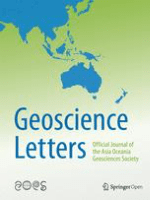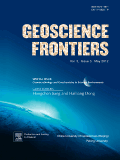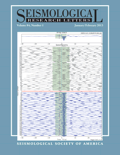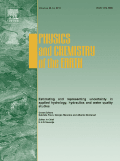
Geoscience Letters
Scope & Guideline
Advancing Earth Knowledge for a Sustainable Future
Introduction
Aims and Scopes
- Earthquake and Seismic Studies:
Research on seismic activity, including the mechanisms of earthquakes, earthquake prediction, and seismic hazard assessments, especially in tectonically active regions. - Climate Change and Environmental Impact:
Investigations into the effects of climate variability and change on ecosystems, hydrology, and geological processes, emphasizing the implications for natural disasters and resource management. - Geophysical and Geological Modeling:
Development and application of modeling techniques, including machine learning and numerical simulations, to understand subsurface structures, geological formations, and dynamic Earth processes. - Tsunami and Natural Hazard Research:
Studies focusing on the causes, impacts, and mitigation strategies of tsunamis and other natural hazards, utilizing historical data and modern methodologies. - Hydrology and Water Resources:
Research on hydrological processes, water quality, and the impacts of land-use changes on water resources, with a focus on sustainable management practices. - Remote Sensing and Geospatial Analysis:
Application of remote sensing technologies and geospatial analysis for environmental monitoring, resource management, and disaster response.
Trending and Emerging
- Machine Learning and Data Assimilation:
There is a growing trend in applying machine learning techniques for data assimilation and predictive modeling in geosciences, indicating a shift towards data-driven approaches that enhance the accuracy of forecasts and assessments. - Impact of Climate Change on Natural Hazards:
Research focusing on the interactions between climate change and natural hazards, such as extreme weather events and their socio-economic impacts, has gained traction, emphasizing the urgency of addressing climate-related risks. - Geophysical Research Utilizing Advanced Technologies:
The use of advanced geophysical techniques, including high-resolution imaging and remote sensing, is trending, enabling more detailed and accurate studies of tectonic processes and subsurface characteristics. - Sustainable Resource Management:
There is an increasing emphasis on studies related to the sustainable management of natural resources, particularly water and land, reflecting a broader societal focus on sustainability and environmental stewardship. - Disaster Risk Reduction and Preparedness:
Research on disaster risk reduction strategies and preparedness measures is emerging, highlighting the importance of integrating scientific knowledge into policy and practice to mitigate the impacts of natural disasters.
Declining or Waning
- Traditional Geological Mapping:
Research focusing solely on conventional geological mapping techniques has decreased, likely due to advancements in remote sensing and geophysical modeling that provide more comprehensive data. - Static Climate Models:
Studies relying on static climate models without consideration of dynamic interactions and feedback mechanisms have become less common, as the field shifts towards more integrated and adaptive modeling approaches. - Single-Disciplinary Studies:
There has been a noticeable decline in purely single-disciplinary studies, with a growing emphasis on interdisciplinary research that combines insights from various fields such as geology, climatology, and ecology. - Historical Geological Events Analysis:
Papers focusing exclusively on historical geological events without contemporary relevance or application have diminished, as researchers increasingly prioritize studies with immediate implications for current environmental challenges.
Similar Journals

Earth and Space Science
Advancing Knowledge in Planetary and Environmental Sciences.Earth and Space Science, published by the American Geophysical Union, is a distinguished open-access journal that has profoundly impacted the realms of earth and planetary sciences as well as environmental science since its inception in 2014. With impressive rankings, including Q1 in both Earth and Planetary Sciences and Environmental Science for 2023, this journal ranks 38th out of 195 in the general Earth and planetary sciences category and 51st out of 219 in environmental science, showcasing its commitment to high-quality research dissemination. The journal serves as a vital platform for researchers, professionals, and students, fostering the exploration of critical topics and advancements within these pivotal fields. With an accessible format, researchers can benefit from the rich content available, furthering their knowledge and ensuring that groundbreaking discoveries reach a broader audience. The journal's ongoing commitment to open access aligns with contemporary trends in scholarly communication, emphasizing inclusion and collaboration in tackling pressing global challenges.

GEOSCIENCES JOURNAL
Charting New Territories in Earth and Environmental Science.Welcome to the GEOSCIENCES JOURNAL, a pivotal publication in the fields of Earth and Planetary Sciences and Environmental Science, proudly presented by the Geological Society of Korea. Established in 1997, this journal has become a prominent platform for researchers, professionals, and students, offering a rich collection of peer-reviewed articles that explore a diverse array of geoscientific topics. With an impressive Q2 ranking in both Earth and Planetary Sciences and Environmental Science categories for 2023, it stands as an essential resource in the academic community. Though it operates under a traditional subscription model, GEOSCIENCES JOURNAL remains dedicated to advancing knowledge through rigorous research. Addressed from its headquarters in Seoul, South Korea, the journal aims to foster a deeper understanding of geosciences, encouraging innovation and collaboration in tackling today’s environmental challenges.

Journal of Asian Earth Sciences-X
Connecting Researchers to Tackle Global Environmental ChallengesJournal of Asian Earth Sciences-X, a distinguished publication by ELSEVIER, is at the forefront of Earth and planetary sciences, particularly focusing on the dynamic fields of geology and earth-surface processes. As an Open Access journal since 2019, it provides unparalleled access to high-quality research, fostering global collaboration and dissemination of knowledge. With an impressive impact factor and ranking in the Q2 category for both Earth-Surface Processes and Geology, it serves as a crucial platform for researchers, professionals, and students alike to share their findings and insights. Situated in the United Kingdom, the journal thrives on contributions that enhance our understanding of Asian geosciences within a broader global context, aiming to tackle major challenges such as climate change and natural resource management. By bridging regional studies with global perspectives, the Journal of Asian Earth Sciences-X is not only a vital resource for academia but also supports sustainable development initiatives across the region.

Russian Journal of Earth Sciences
Innovating research for a sustainable future.Russian Journal of Earth Sciences, published by the esteemed Geophysical Center RAS, is a pivotal resource for researchers and professionals in the field of Earth and Planetary Sciences. With an ISSN of 1681-1208 and an E-ISSN of 1681-1208, this journal has demonstrated a significant trajectory since its inception in 1998, currently converging towards its 2024 goal of disseminating innovative research. The journal holds a respectable position within the academic community, ranked Q3 in Earth and Planetary Sciences by Scopus, placing it at the 44th percentile among the most relevant journals in the field. Though it operates under a traditional access model, its commitment to advancing scientific knowledge ensures that vital research findings are available to a global audience. Located in Moscow, Russian Federation, the journal not only serves as a platform for high-quality research but also fosters a collaborative environment for scholars aiming to contribute to the understanding of our planet's geological phenomena.

EARTH
Transforming understanding through multidisciplinary insights.EARTH is a prestigious journal published by MDPI, located in Switzerland, with a commitment to advancing the fields of Earth and Planetary Sciences and Environmental Science. Launched in 2020, the journal emphasizes an open-access publication model, ensuring that high-quality research is widely accessible to the scientific community and beyond. As of 2023, it proudly holds a Q2 ranking in both the Environmental Science and Earth and Planetary Sciences categories, indicating its significant impact within these disciplines; it ranks #90 out of 219 and #70 out of 159 in their respective fields according to Scopus. With the convergence of multidisciplinary research and the critical challenges our planet faces, EARTH seeks to publish innovative studies that foster a deeper understanding of geological and environmental processes. Researchers, professionals, and students alike will find this journal an invaluable resource for the latest findings and discussions shaping our understanding of Earth sciences.

Geofizika
Fostering Collaboration in Geophysical DiscoveriesGeofizika, an esteemed journal published by the Andrija Mohorovičić Geophysical Institute at the University of Zagreb, presents a significant platform for research in the fields of geophysics and Earth sciences. With an Open Access model established since 1984, this journal ensures that scientific knowledge is accessible to a broad audience, encouraging collaborations and the free exchange of ideas. Geofizika has steadily evolved through its converging years from 1989 to 1999 and has been active from 2003 to the present, reflecting its commitment to advancing geophysical research. The journal has been recognized for its contributions to Earth and Planetary Sciences and has acquired respectable ranks in various categories; notably, it holds a Q4 status in Geophysics as of 2023. Researchers, professionals, and students will find Geofizika a valuable resource for the latest discoveries and methodologies in geophysics, supporting the academic community in expanding the frontiers of knowledge in these vital scientific domains.

Geoscience Frontiers
Pioneering Research for a Sustainable PlanetGeoscience Frontiers is a premier open-access journal that has been at the forefront of disseminating impactful research in the field of Earth and Planetary Sciences since its inception in 2010. Published by China University of Geosciences, Beijing, this journal operates from the Netherlands and has gained recognition for its rigorous peer-review process and high standards of scholarship, earning a distinguished position as Q1 in the Earth and Planetary Sciences category. With a Scopus ranking of 5 out of 195, placing it in the 97th percentile, it reflects the journal's commitment to addressing global geological challenges and advancing our understanding of the Earth’s dynamic systems. As an open-access platform, Geoscience Frontiers ensures that vital research is widely accessible, fostering collaboration and innovation among researchers, professionals, and students alike. By providing a forum for cutting-edge discoveries and theories, the journal plays a critical role in shaping the future of geoscientific research and education.

Vietnam Journal of Earth Sciences
Advancing Knowledge in Earth and Planetary SciencesThe Vietnam Journal of Earth Sciences, ISSN 0866-7187, is a premier publication from the Publishing House Science and Technology based in Viet Nam, dedicated to fostering advancements in the field of Earth and Planetary Sciences. Operating under a Q2 ranking in the 2023 category of Earth and Planetary Sciences (miscellaneous) and positioned at Rank #62 out of 195 in its general category on Scopus, this journal serves as a critical platform for researchers, professionals, and students seeking to disseminate and engage with high-quality scientific findings. Despite being part of the non-open access model, the journal is committed to providing compelling content, encompassing a range of topics from geological hazards to environmental sustainability, ensuring its relevance and contribution to both local and international scientific communities. With coverage that spans from 2018 to 2024, the journal is poised to continue its role in addressing pressing Earth science issues and fostering collaborations among scholars in an increasingly interconnected world.

SEISMOLOGICAL RESEARCH LETTERS
Pioneering insights into the dynamic world of earthquakes.SEISMOLOGICAL RESEARCH LETTERS is a leading journal in the field of geophysics, published by the Seismological Society of America. With its ISSN 0895-0695 and E-ISSN 1938-2057, this prestigious publication serves as a vital platform for disseminating groundbreaking research and advancements in seismological science. The journal boasts an impressive Q1 categorization in the 2023 rankings and ranks 23rd out of 165 in Earth and Planetary Sciences, Geophysics, placing it within the 86th percentile among its peers. Spanning an illustrious history from its origination in 1984 to its ongoing contributions through 2024, it is dedicated to fostering a deeper understanding of seismic phenomena. Although it currently does not offer open access, researchers, professionals, and students can benefit from timely insights and comprehensive studies presented in its pages. Set within the heart of the United States, the journal stands as a cornerstone in geophysics, connecting a global community eager to advance their knowledge and impact in the field.

PHYSICS AND CHEMISTRY OF THE EARTH
Innovating Research in Geophysics and PetrologyThe Physics and Chemistry of the Earth is a premier interdisciplinary journal published by Pergamon-Elsevier Science Ltd, dedicated to advancing the understanding of Earth sciences through the integration of geophysical and geochemical perspectives. With an ISSN of 1474-7065 and an E-ISSN of 1873-5193, the journal serves as a critical platform for researchers and professionals to disseminate key findings and innovative methodologies in the realms of geophysics and petrology. As of 2023, it proudly holds a Q2 ranking in both Geochemistry and Petrology and Geophysics, reflecting its robust impact in the scientific community, with Scopus rankings that position it in the top 20% and 32% of its respective categories. Notably, the journal is available in an open-access format, allowing for greater dissemination and accessibility of research contributions. With a publication history spanning from 1992 to 2024, Physics and Chemistry of the Earth stands as a vital resource for ongoing research and discovery in the Earth sciences, making it an essential read for academics and practitioners alike.